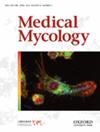Comparison of fungemia caused by Candida and non-Candida rare yeasts: a retrospective study from a tertiary care hospital
IF 2.7
3区 医学
Q3 INFECTIOUS DISEASES
引用次数: 0
Abstract
Although Candida species are the most common cause of fungemia, non-Candida rare yeasts (NCY) have been increasingly reported worldwide. Although the importance of these yeast infections is recognized, current epidemiological information about these pathogens is limited and they have variable antifungal susceptibility profiles. In this study, we aimed to evaluate the clinical characteristics for fungemia caused by NCY by comparing with candidemia. The episodes of NCY fungemia between January 2011 and August 2023 were retrospectively evaluated in terms of clinical characteristics, predisposing factor and outcome. In addition, a candidemia group including the patients in the same period was conducted for comparison. Antifungal susceptibility tests were performed according to reference method. A total of 85 patients with fungemia episodes were included; 25 with NCY fungemia, 60 with candidemia. Fluconazole had high minimal inhibitory concentration (MIC) values against almost all NCY isolates. The MIC values for voriconazole, posaconazole and amphotericin B were ≤ 2 µg/ml and for caspofungin and anidulafungin were ≥ 1 µg/ml against most of isolates. Hematological malignancies, immunosuppressive therapy, neutropenia and prolonged neutropenia, polymicrobial bacteremia/fungemia, preexposure to antifungal drugs and breakthrough fungemia were associated with NCY fungemia, whereas intensive care unit admission, diabetes mellitus, urinary catheters and total parenteral nutrition were associated with candidemia. In conclusion, the majority of fungemia due to NCY species were the problem particularly in hematology units and patients with hematological malignancy. Preexposure to antifungal drugs likely causes a change in the epidemiology of fungemia in favor of non-albicans Candida and/or NCY.由念珠菌和非念珠菌罕见酵母菌引起的真菌血症的比较:一家三级医院的回顾性研究
虽然念珠菌是真菌病最常见的致病菌,但世界各地关于非念珠菌罕见酵母菌(NCY)的报道也越来越多。虽然这些酵母菌感染的重要性已得到认可,但目前关于这些病原体的流行病学信息却很有限,而且它们对抗真菌的敏感性也各不相同。在本研究中,我们旨在通过与念珠菌血症进行比较,评估由 NCY 引起的真菌血症的临床特征。我们对 2011 年 1 月至 2023 年 8 月期间发生的 NCY 真菌血症的临床特征、诱发因素和结果进行了回顾性评估。此外,还对同期的念珠菌血症患者进行了分组比较。抗真菌药敏试验按照参考方法进行。共纳入 85 例真菌血症患者,其中 25 例为 NCY 真菌血症,60 例为念珠菌血症。氟康唑对几乎所有 NCY 分离物的最小抑菌浓度(MIC)值都很高。伏立康唑、泊沙康唑和两性霉素 B 的 MIC 值≤ 2 µg/ml,卡泊芬净和阿尼芬净对大多数分离菌株的 MIC 值≥ 1 µg/ml。血液恶性肿瘤、免疫抑制治疗、中性粒细胞减少和长期中性粒细胞减少、多微生物菌血症/真菌血症、预先接触抗真菌药物和突破性真菌血症与NCY真菌血症有关,而重症监护病房入院、糖尿病、导尿管和全肠外营养则与念珠菌血症有关。总之,大多数真菌血症都是由NCY菌引起的,尤其是在血液科和血液恶性肿瘤患者中。三度接触抗真菌药物可能会导致真菌血症的流行病学发生变化,从而有利于非阿氏念珠菌和/或NCY。
本文章由计算机程序翻译,如有差异,请以英文原文为准。
求助全文
约1分钟内获得全文
求助全文
来源期刊

Medical mycology
医学-兽医学
CiteScore
5.70
自引率
3.40%
发文量
632
审稿时长
12 months
期刊介绍:
Medical Mycology is a peer-reviewed international journal that focuses on original and innovative basic and applied studies, as well as learned reviews on all aspects of medical, veterinary and environmental mycology as related to disease. The objective is to present the highest quality scientific reports from throughout the world on divergent topics. These topics include the phylogeny of fungal pathogens, epidemiology and public health mycology themes, new approaches in the diagnosis and treatment of mycoses including clinical trials and guidelines, pharmacology and antifungal susceptibilities, changes in taxonomy, description of new or unusual fungi associated with human or animal disease, immunology of fungal infections, vaccinology for prevention of fungal infections, pathogenesis and virulence, and the molecular biology of pathogenic fungi in vitro and in vivo, including genomics, transcriptomics, metabolomics, and proteomics. Case reports are no longer accepted. In addition, studies of natural products showing inhibitory activity against pathogenic fungi are not accepted without chemical characterization and identification of the compounds responsible for the inhibitory activity.
 求助内容:
求助内容: 应助结果提醒方式:
应助结果提醒方式:


